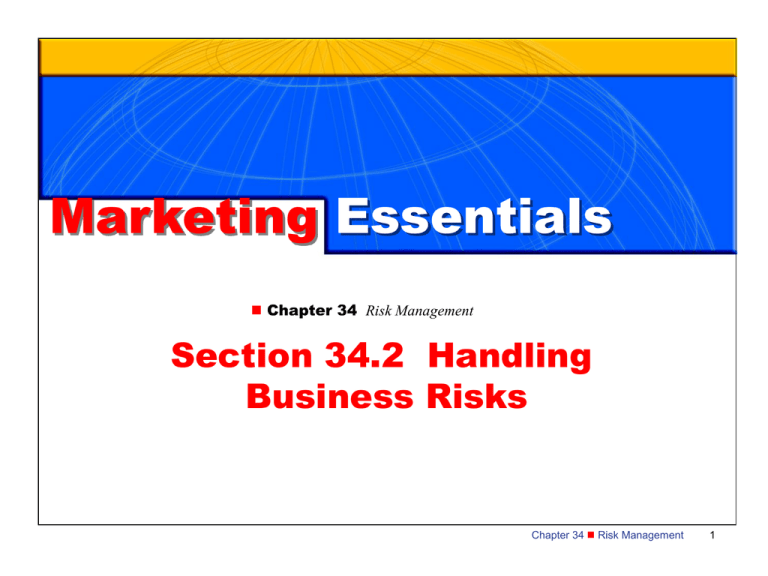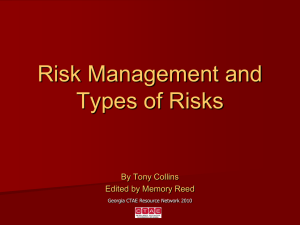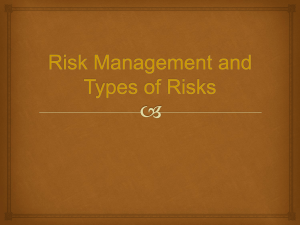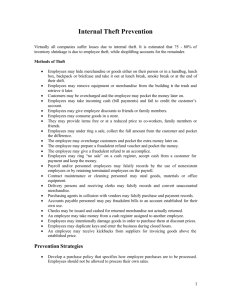Handling Business Risks
advertisement

Marketing Essentials n Chapter 34 Risk Management Section 34.2 Handling Business Risks Chapter 34 n Risk Management 1 SECTION 34.2 Handling Business Risks What You'll Learn The ways businesses handle risks Chapter 34 n Risk Management 2 SECTION 34.2 Handling Business Risks Why It's Important Businesses use certain strategies to help prevent, avoid, and protect against accidents, injuries, fires, thefts, defective products, and environmental disasters. Chapter 34 n Risk Management 3 SECTION 34.2 Handling Business Risks Key Terms insurance policy extended coverage fidelity bonds performance bonds Chapter 34 n Risk Management 4 SECTION 34.2 Handling Business Risks Handling Business Risks There are four basic ways that businesses can handle risks: risk prevention and control risk transfer risk retention risk avoidance Chapter 34 n Risk Management 5 SECTION 34.2 Handling Business Risks Risk Prevention and Control Risks can be prevented and controlled by: screening and training employees providing safe conditions and safety instruction preventing external theft deterring employee theft Chapter 34 n Risk Management 6 SECTION 34.2 Handling Business Risks Screening and Training Employees The best way to prevent the human risk of employee carelessness and incompetence is through effective employee screening, orientation, and training. Properly trained personnel are better able to meet customer needs and wants. This also helps to prevent the risk of lost sales through human error. Chapter 34 n Risk Management 7 SECTION 34.2 Handling Business Risks Providing Safe Conditions and Safety Instructions To prevent employee injuries, businesses can design stock and selling areas for efficient foot traffic and merchandise storage, and provide safety instruction on proper ways to lift and store merchandise Chapter 34 n Risk Management 8 SECTION 34.2 Handling Business Risks Preventing External Theft Shoplifting involves the theft of merchandise from a business. Effective store layouts, security guards, and security devices can help prevent shoplifting. Robbery is the stealing of money or merchandise by violence or threat. Robbery prevention measures including keeping limited cash on hand, installing video cameras, and hiring security guards. Chapter 34 n Risk Management 9 SECTION 34.2 Handling Business Risks Controlling Employee Theft Employee theft is stealing merchandise, funds, or other company property. Effective prevention measures include: Closed-circuit television systems used in conjunction with point-of-sale terminals to monitor employee transactions. Preemployment screening to detect attitudes about honesty. Chapter 34 n Risk Management 10 SECTION 34.2 Handling Business Risks Risk Transfer Some business risks can be handled by transferring the risk to another business or to another party. Three of the most common risk transfers are: insurance product and service warranties transferring risks through business ownership Chapter 34 n Risk Management 11 SECTION 34.2 Handling Business Risks Purchasing Insurance Businesses can insure property and people against potential loss by purchasing an insurance policy— a contract between a business and an insurance company to cover a certain business risk. Businesses can buy several kinds of insurance: Performance bonds Property insurance Business liability insurance Life insurance Personal liability insurance Credit insurance Workers' compensation Product liability insurance insurance Fidelity bonds Slide 1 of 5 Chapter 34 n Risk Management 12 SECTION 34.2 Handling Business Risks Purchasing Insurance Property insurance covers the loss of or damage to buildings, equipment, machinery, merchandise, furniture, and fixtures. It typically covers replacement costs and loss of income. Business liability insurance protects a business against damages for which it may be held legally liable, such as an injury to other persons or damage to others' property. Slide 2 of 5 Chapter 34 n Risk Management 13 SECTION 34.2 Handling Business Risks Purchasing Insurance Personal liability insurance covers damage claims made by customers and employees. Product liability insurance protects against business loss resulting from personal injury from products manufactured or sold by a business. Fidelity bonds protect a business from employee dishonesty. Slide 3 of 5 Chapter 34 n Risk Management 14 SECTION 34.2 Handling Business Risks Purchasing Insurance Performance bonds (surety bonds) insure against losses that might occur when work is not finished on time or as agreed. Life insurance is often purchased by a business owner to ensure that there will be sufficient funds to pay business debts in the event of the owner’s death. Slide 4 of 5 Chapter 34 n Risk Management 15 SECTION 34.2 Handling Business Risks Purchasing Insurance Credit insurance protects a business from losses on credit extended to customers. Credit life insurance pays the balance of any loans in the event the borrower dies. Workers' compensation insurance is paid by employers to cover employee job-related injuries and illness . Slide 5 of 5 Chapter 34 n Risk Management 16 SECTION 34.2 Handling Business Risks Product and Service Warranties Warranties are promises by the seller or manufacturer concerning the performance and quality of a product and protection against loss. Chapter 34 n Risk Management 17 SECTION 34.2 Handling Business Risks Transferring Risks Through Business Ownership The corporate form of ownership offers the most protection from losses, because the stockholders, as owners, have only limited liability for business risks. Chapter 34 n Risk Management 18 SECTION 34.2 Handling Business Risks Risk Retention In some cases, it is impossible for businesses to prevent or transfer risks, so they retain or assume responsibility for them. This is called risk retention. This can happen because a business is not aware of the risk, underestimates the risk, or simply accepts the risk. Chapter 34 n Risk Management 19 SECTION 34.2 Handling Business Risks Risk Avoidance Certain risks can be avoided by anticipating them in advance. Market research can lead businesses to conclude that investment in a product is not worth the risk. Chapter 34 n Risk Management 20 34.2 ASSESSMENT Reviewing Key Terms and Concepts 1. Identify the four ways businesses handle risk. 2. Name four ways that companies prevent and control risks. 3. How can businesses reduce the human risk of on-the-job injuries? 4. What are the three principal ways to transfer risk? 5. What is the difference between risk retention and risk avoidance? Chapter 34 n Risk Management 21 34.2 ASSESSMENT Thinking Critically What important factors should a business consider when selecting an insurance company? Chapter 34 n Risk Management 22 Marketing Essentials End of Section 34.2 Chapter 34 n Risk Management 23










